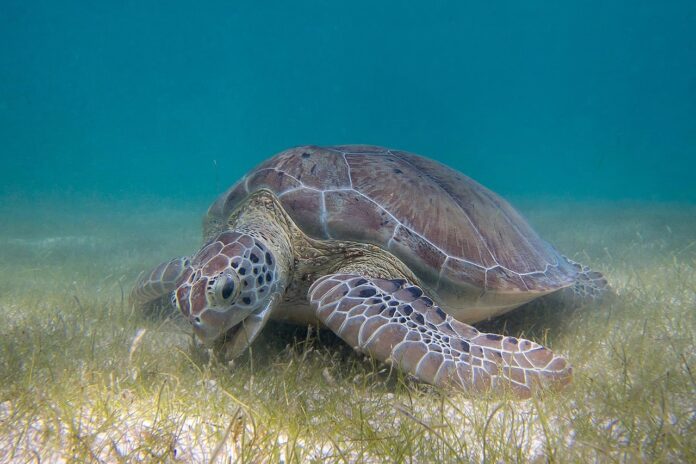Seagrasses are an important element of the marine food chain that live beneath the waves of coastal waterways. In many respects, these marine meadows are the unsung heroes of the ocean, helping us and the world by creating oxygen, absorbing carbon dioxide from the atmosphere, and providing food and habitat for marine life.
A new study modeled the distribution of seagrass species around the planet at two alternative future time points, showing that these submerged savannahs may be on the verge of extinction.
Climate change is projected to significantly impact marine species, partly because oceans absorb an estimated 80% of extra heat from greenhouse gas emissions. However, it is still being determined how seagrasses will fare in the future or whether the current network of marine protected areas will be sufficient to maintain seagrasses.
Barnabas Daru, assistant professor of biology at the Stanford School of Humanities and Sciences, said, “The simple question we ask in this paper is, ”How will seagrasses – a foundational group in the marine food chain – respond to climate change?”
Seagrasses are a kind of plant that originated in the sea, went to land, and then returned to the sea 140 million years ago. They serve as grazing areas for herbivores such as endangered green sea turtles, manatees, and parrotfish, as well as a haven for prawns, marine invertebrates, and fish. They also serve as a nursery for nearly 20% of the world’s large commercial fisheries.
Many marine creatures depend directly on seagrasses for survival, but many more benefit indirectly.
For example, Sharks eat marine animals, which may feed directly or indirectly on plants. Suppose something happens to these foundational species at the bottom of the food chain. In that case, it will have a knock-on effect on other organisms higher up the food chain, including humans.
Barnabas Daru from Stanford University said, “If anything affects these foundational species at the beginning of the food chain, it will have cascading effects on other organisms that depend on them high up in the food chain, including humans.”
The study found that seagrass species diversity and composition will suffer widely, with a considerable proportion of seagrasses suffering in hotspots outside the current marine network of marine protected areas.
Seagrasses cover approximately 116,000 square miles of shoreline, bordering 191 countries on all continents except Antarctica. It is not easy to predict how climate change may affect seagrasses around the planet.
The researchers discovered that seagrass abundance and composition decreased in every scenario they investigated, even the “best case” one.
The new study also suggests that the current network of marine protected zones needs to be improved.
One of the characteristics of this modern era of significant human impact on the environment is not even the extinction of species but the reorganization of biotic communities.
The homogenization of communities is likely to have a more significant impact on biodiversity than species extinction. Ecosystems lose their identity and uniqueness as they become homogenized, making them more vulnerable to disease and harsh weather.
Daru and Rock began by mapping the location and quantity of each seagrass species using seagrass samples gathered from coastal environments over 100 years. They merged these data with field reports and information from public databases on seagrass occurrences, such as the Global Biodiversity Information Facility and Seagrass-Watch.
They overcome unequal sampling by modeling projected seagrass habitats for undersampled areas such as Southeast Asia and the Indo-Pacific using data from well-sampled places such as North America and Europe.
Using geophysical and environmental data from the Bio-ORACLE website, they then constructed global “snapshots” of the ocean’socean’s climate today and how it would be in 2040-2050 and 2090-2100.
Daru modeled four possible scenarios for the present and two future periods: a “best-case” climate with low greenhouse gas concentrations, two stabilized scenarios with plateaued greenhouse gas levels, and a “worst-case” scenario with high greenhouse gas concentrations.
These simulated scenarios included data on sea temperature, salinity, and current speed, all known to impact seagrass growth, distribution, and photosynthesis substantially.
The study revealed that seagrasses would incur widespread species diversity and composition reductions, with a significant proportion suffering in hotspots outside the current marine network of protected areas.
Notably, the researchers found that seagrasses declined in abundance and composition under every scenario they tested, even the “best case” scenario. So what does this mean?
The researcher said, “It probably means that ”the best” is still insufficient. We have to be more intentional in prioritizing conservation efforts, and this sort of analysis points to the places where these efforts should be made.”
A change of this magnitude could impact both the ecosystem services provided by these communities and the marine species that rely on them. It may also require marine animals that specialize in specific seagrass species to relocate or adapt to less desired seagrass species if their chosen seagrass is gone, reducing their fitness and survival.
Despite these depressing discoveries, seagrasses’seagrasses’ future is far from hopeless. By directing policymakers and conservationists to these hotspots, marine protection will be increased in these places, and the future of seagrasses will be somewhat preserved.
Journal Reference:
- Barnabas Daru, B.H., Rock, B.M.et al. Reorganization of seagrass communities in a changing climate. Nature Plants. DOI: 10.1038/s41477-023-01445-6
